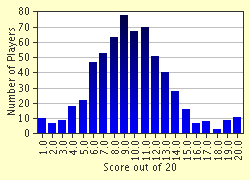Quiz Answer Key and Fun Facts
1. In the beginning . . . there were many ways of keeping local time. One method, which didn't work on overcast days or at night, was the sundial. On what other factor was operation of a sundial dependent?
2. We have 24 hours in a day, 60 minutes in an hour, and 60 seconds in a minute. To what ancient people do we owe this system based on the number 60?
3. In the middle ages, mechanical clocks with gears and pulleys began to be built. One such clock, dating from the 13th century, is thought to be the oldest mechanical clock still in working order. In what English cathedral is it located?
4. Mechanical timekeeping took a great leap forward in 1656, when what inventor built the first pendulum clock?
5. The 'celestial clock' -- the telling of time from the apparent movements of the stars -- is based on the motion of what heavenly body against a background ('reference frame') of fixed stars?
6. As the 17th century ended, the need for an accurate seagoing clock became paramount, as empires expanded across the oceans. Without a clock, there was no way to determine longitude, or east-west position, and many ships were lost as a result. Why couldn't the new pendulum clocks be used?
7. The British government was particularly anxious to have the longitude problem solved, and offered a huge prize (20,000 pounds) to anyone who could produce a seagoing clock. Meanwhile, the Royal Observatory at Greenwich continued work on the 'celestial clock'. John Flamsteed began by compiling a reference frame of stars; what famous scientist, succeeding Flamsteed as Astronomer Royal, continued the work by charting the foreground motions of a body in the solar system?
8. In the 1720s, a self-taught English clockmaker thought he had found a solution to the longitude problem. What was his name?
9. His first model, the H1, used wooden gears instead of metal ones, so that it wouldn't need to be messily lubricated, and it replaced a pendulum with what other mechanism?
10. His third model, H3, included two innovations frequently used in modern machinery: the caged roller bearing (precursor to our ball bearings) for less friction, and the bimetallic strip to deal with what other problem?
11. Not even the H3 was reliable enough as a clock for seafarers. In 1761, the master clockmaker's son put his fourth and final model, H4, to the test. It was inspired by what newly-emerging timekeeper, subject of much contemporary ridicule?
12. While the H4 seafaring clock succeeded in the task assigned it by the Longitude Commission, its mettle was proved when a copy (K1) accompanied what famous explorer on a three-year voyage, never losing more than 8 seconds per day?
13. The next major advance in timekeeping occurred in the 1930s, with the quartz crystal oscillator -- a device used by just about everyone who owns a wristwatch. The quartz crystal as a timepiece is based on a combination of piezoelectricity and what principle?
14. As both astronomy and timekeeping grew more advanced, it was discovered that the earth does not rotate at a constant rate. It was then decided to move to an atomic standard, where one second is defined as 9,192,631,770 transitions of what element?
15. Standard cesium clocks are very accurate over longish time-scales, but they can lose accuracy when it gets down into micro- and nanoseconds (one-millionth and one-billionth, respectively). What other kind of atomic clock measures time over the short term?
16. The next wave of atomic clocks is the cesium fountain, which involves rapid temperature changes. One of the target temperatures is within a few billionths of a degree of what famous temperature constant?
17. What relatively new technology makes it so important to have accurate timekeeping over such tiny intervals?
18. What institution is responsible for measuring and distributing correct time in the United States?
19. On the light side: what surrealist painter created a famous painting featuring melting clocks and watches?
20. In closing: the world's atomic clocks never had a problem with the Y2K bug, since on the whole they measure long timescales not in years, but using what kind of daily measurement?
Source: Author
CellarDoor
This quiz was reviewed by FunTrivia editor
rossian before going online.
Any errors found in FunTrivia content are routinely corrected through our feedback system.

